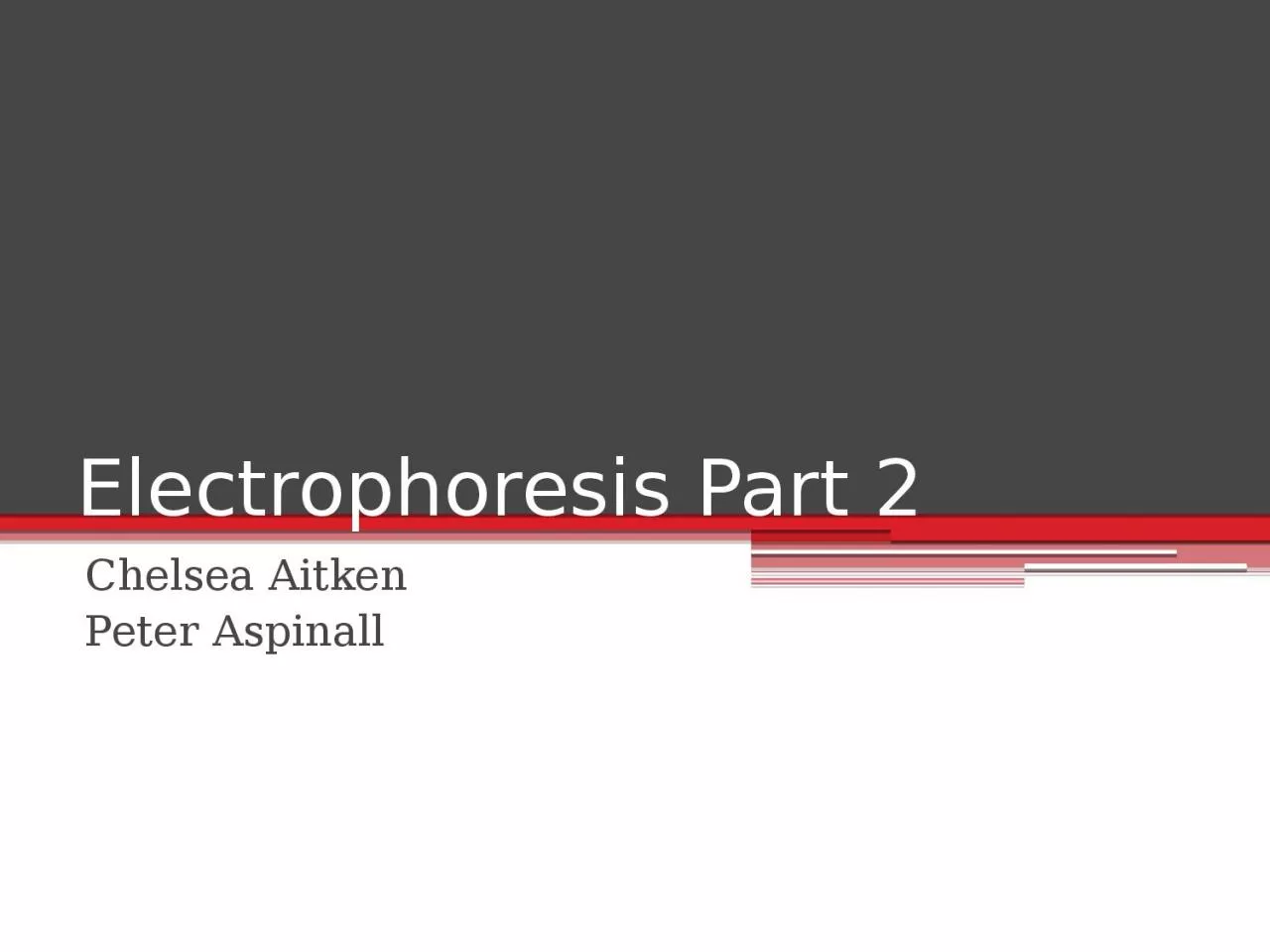

Peter Aspinall Zonal Electrophoresis Most common form of electrophoresis in biological studies Uses a support system most commonly gel to separate proteins by their properties We will cover methods to separate by ID: 1046909
Download Presentation The PPT/PDF document "Electrophoresis Part 2 Chelsea Aitken" is the property of its rightful owner. Permission is granted to download and print the materials on this web site for personal, non-commercial use only, and to display it on your personal computer provided you do not modify the materials and that you retain all copyright notices contained in the materials. By downloading content from our website, you accept the terms of this agreement.
1. Electrophoresis Part 2Chelsea AitkenPeter Aspinall
2. Zonal ElectrophoresisMost common form of electrophoresis in biological studiesUses a support system, most commonly gel to separate proteins by their propertiesWe will cover methods to separate by:Size (Through Frictional Properties)ChargeBothhttp://www.biologyreference.com/images/biol_02_img0140.jpg
3. GelsTwo main types of gelsAgaroseSeaweed based linear polysaccharideMechanical properties are determined by the percentage of AgarosePolyacrylamide (PAGE)Cross-linking acrylamide polymerFirmness and pore size are determined by percentage of PAGE present and bisacrylamidehttp://www.rsc.org/ej/SM/2010/b926713a/b926713a-f2.gifhttp://chemwiki.ucdavis.edu/@api/deki/files/11311/=image084.png
4. SDS Gel ElectrophoresisSeparates proteins by sizeProteins are denatured and negatively-charged sodium dodecyl sulfate (SDS) is addedSDS binds to every two amino acids causing the protein to have a negative chargeSDS polypeptides move through a gel at a rate dependent on their mass
5. SDS Gel ElectrophoresisProtein is placed into a gel in a conductive solution and then pulled towards a positive electrodeThe distance travelled in the gel is related logarithmically to the sizeA control sample with known sizes is used to determine the sizes of the unknown sampleshttp://ocw.mit.edu/courses/biological-engineering/20-109-laboratory-fundamentals-in-biological-engineering-fall-2007/labs/mod1_2_photo.jpg
6. SDS Gel ElectrophoresisLog of the molecular weight versus the distance traveled through the gel is plotted on a semi log plotKnown sample is used to create a lineUnknowns are determined using the equation of the linehttp://www.thermoscientificbio.com/uploadedImages/Products/Protein_Electrophoresis/Protein_Ladders/26610-ladder-002.jpg
7. Isoelectric Focusing (IEF)Separates proteins by chargeSeparates amphoteric molecules in a pH gradientAmphoteric molecule are molecules whose charge is dependent on pHThey all have a pI point where they have neutral chargeWhen a pH gradient is created across a gel, the amphoteric molecule will be pulled by the electrode until it reaches its pI pointOnce it is neutral, it is no longer affected by the electrodes
8. Understanding IEFpKa of the carboxylic acid is around 2.2pKa of the amine group is 9.4When pH > pKa, the group is deprotonatedWhen pH < pKa, the group is protonatedhttp://2.bp.blogspot.com/_s6tOoXRKRX8/S-lvMEOq91I/AAAAAAAAAQQ/VMnZjf-DFGk/s400/222.jpg
9. Two-Dimensional Gel ElectrophoresisSeparates by both size and chargeIEF is first used on a gel stripThe strip is then mounted on a gel slab and SDS PAGE is usedProteins can be later removed from gel to identifyGreat for large scale comparisons (proteomics)
10. Capillary Electrophoresis (CE)Alternative method to gel electrophoresisProteins are dragged through a capillary tube rather than a gelDetector uses UV light absorbance readings to identity whether a protein separation has passed through
11. CE InjectionFirst the capillary tube has to be loaded with bufferThree methods:Apply pressure or vacuum to one sideUse a gravity siphonDrive the buffer in using a potential difference
12. CE FormulasThere are two equations for CEFirst we define the electrophoretic mobility:So to minimize μ, high voltage and short capillary are idealHowever we are constrained due to heat production from our power sourceThen we can look at the separation efficiency:This is in terms of the theoretic plates, which is an evaluation of the resolution of the separation
13. Electroosmotic Flow (EOF)Driving force in CEDrives both anions and cations towards the cathodeWalls of the capillary are negatively chargedThis binds cations from the bufferThe cation layer that forms is attracted to the cathode and drives the flow towards the cathodeEOF can be reversed or completely removed by changing the charge on the capillary wallshttp://micromachine.stanford.edu/~dlaser/images/eof_capillary.jpg
14. Ultrafast Capillary ElectrophoresisIt is possible to speed up separationUsing an hourglass shape in the capillary increases the electric field at a specific point (reducing the risk of overheating)As cross-sectional area decreases electric field magnitude increases, this allows very large electric field at the mid point with relative low input voltage
15. Two-Dimensional CEPerformed similarly to 2-D gel electrophoresisCE is performed in a one-dimensional capillaryThe capillary is then connected to a series of parallel capillariesThen a second separation is performed
16. ChiralityChirality is the “handedness” of a moleculeChiral molecules are non-superimposable mirror images of each otherWhile identical in structure, chiral molecules can have vastly different propertiesPharmaceutical applicationsThalidomideOne enantiomer helps with morning sicknessThe other enantiomer causes birth defects
17. Separation of Chiral MoleculesCE is performed with Cyclodextrin in the bufferCyclodextrin is a non-ionic, cyclic, chiral moleculeOne enantiomer will react much more strongly with cyclodextrinThis enantiomer will reach the detector laterInteraction with the cyclodextrin slows down the migration of this enantiomer
18. Capillary Electrochromatography (CEC)Uses EOF to move through a columnSorbent in column will interact differently with different moleculesMolecules with migrate at different rates based on their charge and based on their interactions with the sorbent in solutionBy adding an additional determining factor, it becomes easier to distinguish between molecules that would otherwise look similar (in CE)
19. SourcesSerdyuk, Igor N., Nathan R. Zaccai, and Joseph Zaccai.Methods in Molecular Biophysics: Structure, Dynamics, Function. New York: Cambridge University Press, 2007. Print.Voet, Donald, Judith G. Voet, and Charlotte W. Pratt.Fundamentals of Biochemistry: Life at the Molecular Level. 4th ed. John Wiley & Sons, Inc., 2013. Print."Capillary Electrophoresis." Sam Houston State University. N.p.. Web. 6 Oct 2013. <http://www.shsu.edu/chm_tgc/sounds/flashfiles/CE.swf>.Clark, Jim. " HIGH PERFORMANCE LIQUID CHROMATOGRAPHY - HPLC."ChemGuide.co.uk. N.p., n.d. Web. 6 Oct 2013. <http://www.chemguide.co.uk/analysis/chromatography/hplc.html>.